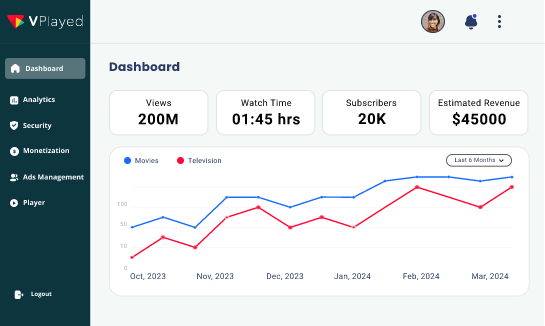H.265/HEVC Codec: The Best Compression Standard for VOD & Live Streaming
Videos created professionally are of insanely high quality and thus have a significantly big size. These videos aren’t suitable for public viewing since such raw videos cannot be processed by commonplace CPUs and home computers.
These videos need to be compressed to a point where they are runnable on PCs but without any loss in visual quality. Compression standards like H.265 exist for this very purpose.
Table of Contents
What is H.265?
H.265 or High Efficiency Video Coding(HEVC) is a compression standard for video streaming and a successor to the widely used H.264 or Advanced Video Coding(AVC) standard.
Online video streaming is on the rise and with 4K quality recording technology in most cameras, it is essential that such videos are stored and streamed smoothly across multiple devices.
Here is an over-simplified version of how HEVC works:
- When a raw video is processed to run, each and every frame of the video stores a different information irrespective of the information in that frame.
- HEVC analyses this information and only processes those areas that change between frames while generalising the static areas.
- This way, the algorithm remembers lesser information between frames, thus reducing the overall size.
This process is known as inter-frame compression and is only one of the many methods HEVC uses to compress a video without compromising quality.
H.265(HEVC) vs H.264(AVC) Compression
The first version of H.264 was approved in 2003, and since then H.264 has been a prime choice for video compression. Google’s compression algorithm called VP8 emerged as a potential competitor but didn’t quite stick as well as H.264 did.
H.265, being an upgraded version of H.264, is quite similar to its predecessor is many ways. All of AVC’s features are present in HEVC along with a few more that make it more superior.

A few advantages of using H.265/HEVC over H.264/AVC are given below:
- Significantly improved bit-stream
- Enhanced optimizations and coding quality
- Bigger CTU(Coding Tree Units) size leading to improved CTU segmentation and motion compensation
- Reduced amount of processing needed for decompression
- H.264/AVC requires 32 MB/s bandwidth for 4K transmission while H.265/HEVC requires only around 15 MB/s.
How H.265/HEVC Impacts Live Streaming
Live streaming any video, especially if it’s a big event like the Oscar Awards or the Premiere League finals, is a critical task and requires perfect live streaming equipment (both hardware and software).
Live streaming requires transcoding a raw 4K video recording into a digital format that can be transmitted online without lags or breakages.
There’s a lot of pressure and time constraints under which the live stream has to come out impeccable and smooth. H.265 makes this process a thousand times easier.
Quality
– H.265 protocol converts and compresses the raw file enough to transmit online seamlessly even at average speeds without any visible loss in quality.
Speed
– A smaller file size can work with lower streaming speeds. A 1080p H.264 live stream would require 8 MB/s bandwidth while the same live stream with H.265 compression would only need 4 MB/s. This makes H.265 the best choice for data-strapped locations.
Encoding
– Since the file size decreases significantly, encoding time (time taken to make the video digitally compatible) id greatly reduced, leading to faster transmission of video across long distances.
Cost
– HEVC-enabled encoders slash the bit-rate of the live stream in half when compared to an AVC encoder. Therefore HEVC saves more data, and hence more money, than AVC in broadcasting the same video at the same resolution.
The only limitation to H.265 is that it requires hardware accelerated decoding (something similar to a powerful graphics card with HEVC support). Without it, the video may suffer from stuttering, delay and/or become very slow.
Where Does Vplayed Fit in all this?
Considering the fact that H.265 is the upcoming video compression standard that’s going to sit at the epitome of all recording and transcoding hardware and software, we have made sure to incorporate this algorithm into Vplayed’s video on demand solution. We believe in a future-centric approach in solving the OTT platform streaming needs in order to provide scalable solutions to our clients. H.265 compatibility in our player is only one of many other features that make Vplayed a white-label video enterprise-grade solution.

